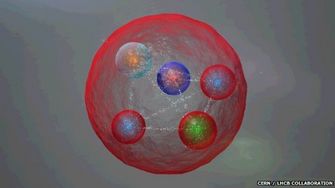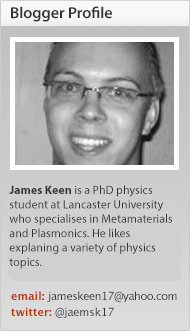« Prev Next »
Gravitational Waves have been detected, after a long search, a century after they were first said to exist by Einstein.

Like the ripples seen when a stone is dropped into a pond, Gravitational Waves are ripples in the fabric of spacetime, moving through the Universe at the speed of light away from catastrophic events in the cosmos.
Predicted to exist by Einstein in his theory of General Relativity, published a century ago in 1906, they are the result of massive objects causing distortions in spacetime. This effect is felt by us as gravity. But until now their existence had only been inferred not directly detected.
The waves are incredibly weak so most have no measureable effect. The only sources which were believed to possibly emit strong enough signals that could maybe be detected are those with incredibly strong and varying gravity, for example black holes.
Today their discovery has been formally reported by scientists working at LIGO (Laser Interferometer Gravitational Wave Observatory) in USA. The signals originating from the combining of two black holes almost a billion light years ago have reached Earth and were detected by LIGO.

The Ligo experiment is rather simple, and has an L-shaped design. A laser beam at the centre is split into two and the parts sent in perpendicular directions (at 90°) along identical tunnels, in which they bounce back and forth. Graviational waves travelling through the equipment may cause disturbances by stretching or squeezing space, meaning that the light in one of the beams will travel a distance a tiny bit different to that of the other. This change of size will be only about the width of an atom, but due to the length of the paths (about 4km) and the incredible sensistivity of the LIGO setup this can be detected.
The two parts of LIGO are sufficiently separated to allow noise such as traffic or Earth tremours to be disregarded and ensure any signal is only from the faint gravitational waves. The first run of LIGO from 2002-2010 was unable to detect anything, but since being upgraded in 2015 to Advanced LIGO the significantly increased sensitivity of the detectors has enabled the detection of gravitational waves now reported.
To appreciate what LIGO is able to achieve, if it could measure the distance between the sun and the nearest star Alpha Centauri about 3 light years away, LIGO is capable of measuring this distance to the accuracy of the width of a single human hair. It is this incredible sensitivity which is required to detect gravitational waves.
Detection of gravitational waves promises great advancements in astronomy, providing a new way to observe the Universe. Becuase these waves travel through matter, there are no shadows which can hide their source. Gravitational wave astronomy will be able to provide a better view of mysterious objects such as black holes, things previously invisible by use of optical telescope, and further understanding of the early Universe just moments after the Big Bang. Gravity can be better undersoood, and lead to the long desired Theory of Everything.
The findings are reported here in Phys. Rev. Lett.
Image credits:
Ripple Effect - sea turtle, Flickr
Aerial photo of LIGO - NASA
The 2015 Nobel prize in physics has been announced - congratulations Takaaki Kajita and Arthur McDonald.
This award recognises their work on neutrinos, specifically "for the discovery of neutrino oscillations, which shows that neutrinos have mass".
So, what are neutrinos?

Neutrinos are electrically neutral elementary particles, which come in three 'flavours' or types - electron neutrinos (νe), muon neutrinos (νμ) and tau neutrinos (ντ). Each flavour has its own antiparticle, called antineutrinos. Neutrinos can be created in different ways - radioactive decay, in nuclear reactions and in nuclear reactors. The majority of the neutrinos near Earth are produced from nuclear reactions in the Sun. Theoretical calculations say that about 65 billion neutrinos pass through every square centimeter region of the Earth's surface every second, yet they are incredibly difficult to detect.
Because neutrinos are neutral they are not affected by the electromagnetic force that acts upon charged particles, and also as they are leptons they are not affected by the strong force that acts upon particles within atomic nuclei. They do interact with the weak force but this is a short range interaction, and also interact with gravity but this is weak on the subatomic scale. Therefore typically neutrinos will pass straight through normal matter unaffected and undetected.

Neutrino detectors are huge structures. There is the Super-kamiokande detector in Japan, where Professor Kajita works, and the Sudbury Neutrino Observatory in Canada run by Professor McDonald. The Super-K detector is located 1km underground. It consists of a huge steel tank holding 50,000 tons of ultra-pure water. On the sides are mounted 11,000 photomultiplier devices to detect photons. When a neutron interacts with electrons in the water, a charged particle can be produced. This charged particle travels faster than the speed of light in the water, giving off Cherenkov radiation, a burst of light similar to a sonic boom. This light is registered, indicating that a neutrino has interacted and hence been detected.
Why is the study of neutrinos important in physics?
Their work solved a puzzle - that only about 1/3 of all the neutrinos theoretically expected to be bombarding Earth were actually detected. The solution to the mystery was that these missing neutrinos had infact changed indentities. For example, an electron neutrino produced in a Β-decay reaction may arrive at a detector as a muon neutrino. For this to be true it implies that neutrinos, for a long time thought to be massless, must have mass. This mass is incredibly small, less than one millionth the mass of an electron, but the fact it is non-zero is of great significance.
The use of neutrinos for communication has been demonstrated, potentially allowing for information to be coded in coherent beams of neutrinos which could travel immense distances throgh dense materials. In astrophysics neutrinos are useful for probing astronomical sources because they are not significantly affected by their travel through interstellar space, whereas photons can be obscured by things such as dust or background radiation. The observation of supernovae, the explosions produced by dying stars, is possible by detecting neutrinos which are the only particles known to escape. Neutrinos are currently identified as a candidate for what makes up dark matter, the mysterious entity making up most of the Universe.
Image Credits:
Neutrino event in bubble chamber - Argonne National Laboratory
Inside Super-K detector - Kamioka Observatory, ICCR, University of Tokyo
Physicists at the LHC have discovered a new particle - the pentaquark.
The existence of pentaquarks was theorised half a century ago in the 1960s but so far they had been unable to be found, a story similar to that of the long-elusive Higgs boson which was finally discovered in 2012.
But what is a pentaquark? What is a quark?
Quarks are fundamental particles and an essential component of matter, combining to form composite particles called hadrons, of which there are baryons and mesons. Important baryons are protons and neutrons, which make up atomic nuclei. The quark model was proposed by both Gell-Mann and Zweig seperately in 1964 as a way of ordering hadrons, and since their discovery quarks have been key components of the Standard Model of particle physics.

Quarks are only found together within hadrons, and never on their own - a phenomenon called colour confinement. They have various basic properties including electric charge, mass, and spin. Also, they are the only fundamental particles to experience all four fundamental forces - electromagnetism, gravity, strong interaction and weak interaction. Every type of quark has a corresponding antiquark, that differ in that some properties have equal magnitiude but an opposite sign.
There a six types of quarks, called flavours - up (u) and down (d), strange (s) and charm (c), top (t) and bottom (b). Up and down quarks are the most common in the universe, whereas the other four can only be produced in high energy collisions such as cosmic rays or within a particle accelerator. Experiments at the Stanford LAC in the late 1960s provided evidence of quarks, and subsequent experiments at particle colliders have gathered evidence for all six flavours, with the top quark the last to be discovered in 1995.
Quarks are all assigned a baryon number of ⅓. Up, charm and top quarks have an electric charge of +⅔, while the down, strange, and bottom quarks have an electric charge of -⅓. Antiquarks have the opposite numbers. Baryons are made of three quarks (thus have a baryon number of 1) for example the proton (uud; charge=+1 ) and neutron (udd, charge=0), whereas mesons are made of a quark-antiquark pair (thus have a baryon number of 0).
Whilst usually thought of existing in threes and twos, the theories on quarks allowed for the existence of the pentaquark - a particle composed of five quarks, specifically made up of four quarks and an antiquark.

The pentaquark has a long history of doubtful discovery. In the past many scientists from many different research groups have all claimed to discover pentaquarks, but all were cast into doubt by subsequent alternative work. It is crucial to distinguish real signals from merely data fluctuations that can lead to erroneous conclusions of finding something.
Physicists at the LHCb studied how a subatomic particle called Lambda-b decayed into three other particles. The production of these particles sometimes involved intermediate states, referred to as Pc(4450)+ and Pc(4380)+. They conclude that this transformation can only be explained by the existence of these pentaquark states, and therefore can claim the discovery of the elusive pentaquark particle.
Adding further weight to their claim the data was able to be analysed from additional perspectives, specifically all four angles particles can move within the LHCb, allowing everything that happens in the decay process to be described. Previous experiments only measured the so-called mass distribution that can produce a statistical peak against background noise that just hints at a particle existing.
This discovery is not just important because of finding a new particle but because it confirms a entirely new way that quarks, the building blocks of matter, can exist together. Studying pentaquarks further may well enable a better understanding of how our world is made up.
Image credits:
"Standard Model of Elementary Particles" - MissMJ; licenced under CC via Wikimedia Commons
"Possible illustration of Pentaquark layout" - CERN/LHCb collaboration, image via BBC
























